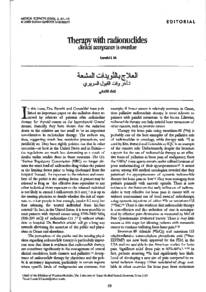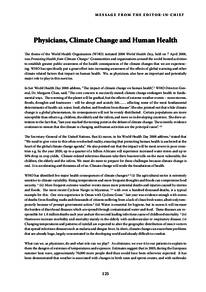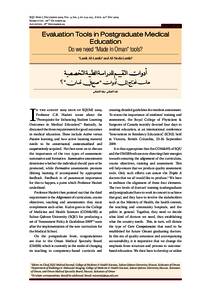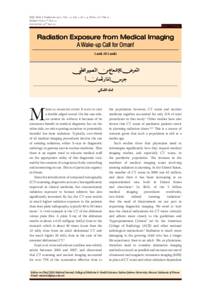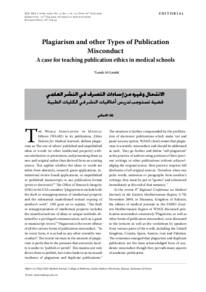وثيقة
Therapy with radionuclides, clinical acceptance is overdue.
عناوين أخرى
العلاج بالنويدات المشعة: تاخر وقت القبول السريري
الناشر
College of Medicine, Sultan Qaboos University.
ميلادي
2000-01
اللغة
الأنجليزية
الموضوع
الملخص الإنجليزي
In this issue, Drs. Bererhi and Constable' have published an important paper on the radiation doses received by relatives of patients after radioiodine therapy for thyroid cancer or for hyperthyroid Graves' disease. Basically, they have shown that the radiation doses to the relatives are too small to be an important consideration in radioiodine therapy. The authors are, thus, suggesting much less restrictive precautions, and justifiably so. They have rightly pointed out that in other countries-at least in the United States and in Britain- the regulations are much less demanding as a result of similar earlier studies done in those countries. The US. Nuclear Regulatory Commission (NRC) no longer dic- tates the exact load of radioactive drug within the patient as the limiting factor prior to being discharged from the hospital. Instead, the exposure to the relatives and members of the public is the limiting factor. A patient may be released as long as 'the effective dose equivalent to any other individual from exposure to the released individual is not likely to exceed 5 millisieverts (0.5 rem).2 It is up to the treating physician to decide whether the risk of exposure to other people is low enough, (under 0.5 rem) before releasing the treated individual from his / her control.2 In fact, in the United States, it is now possible to treat patients with thyroid cancer using 3700-7400 MBq (100-200 mCi) of radioiodine-131 (1311) without admission to hospital. Dr. Bererhi's article' will go a long way towards alleviating the anxieties of the public and physicians in Oman and elsewhere.
برعاية
SQU
المجموعة
URL المصدر
الملخص العربي
في هذا العدد ، د. نشر بيريري وكونستابل ورقة مهمة عن جرعات الإشعاع التي يتلقاها أقارب المرضى بعد العلاج باليود المشع لسرطان الغدة الدرقية أو مرض فرط نشاط الغدة الدرقية. في الأساس ، أظهروا أن جرعات الإشعاع للأقارب صغيرة جدًا بحيث لا يمكن اعتبارها اعتبارًا مهمًا في العلاج باليود المشع. وبالتالي ، فإن المؤلفين يقترحون احتياطات أقل تقييدًا بكثير ، وهذا له ما يبرره. لقد أشاروا عن حق إلى أنه في بلدان أخرى - على الأقل في الولايات المتحدة وبريطانيا - فإن اللوائح التنظيمية أقل تطلبًا نتيجة لدراسات سابقة مماثلة أجريت في تلك البلدان. الولايات المتحدة. لم تعد لجنة التنظيم النووي (NRC) تحدد الحمل الدقيق للعقار المشع داخل المريض كعامل مقيد قبل خروجه من المستشفى. وبدلاً من ذلك ، فإن التعرض للأقارب وأفراد الجمهور هو العامل المحدد. قد يتم إطلاق سراح المريض طالما أن `` الجرعة الفعالة المكافئة لأي فرد آخر من التعرض للفرد الذي تم إطلاق سراحه من غير المحتمل أن تتجاوز 5 مللي سيفرت (0.5 ريم) .2 الأمر متروك للطبيب المعالج لتقرير ما إذا كان خطر التعرض لأشخاص آخرين منخفض بما فيه الكفاية ، (أقل من 0.5 ريم) قبل تحرير الشخص المعالج من سيطرته .2 في الواقع ، في الولايات المتحدة ، من الممكن الآن علاج مرضى سرطان الغدة الدرقية باستخدام 3700-7400 ميغا بايت (100- 200 mCi) من اليود المشع 131 (1311) دون الدخول إلى المستشفى. مقال الدكتور بريري "سيقطع شوطا طويلا نحو التخفيف من قلق الجمهور والأطباء في عمان وغيرها.
قالب العنصر
مقالات الدوريات

